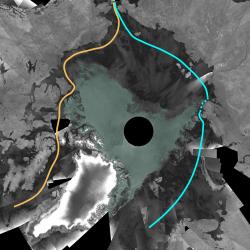Written by Fraser Cain

Here in Vancouver, we have a maritime museum with the first ship to completely circumnavigate North America, and the second vessel to complete a voyage through the Northwest Passage - the St. Roch. Their journey was long and difficult, taking 28 months to cross above North America. And just think, if they'd waited until now, they could sail right across with clear waters the whole way. Satellite photos show that Arctic ice levels have reached their lowest point in recorded history, opening up the Northwest Passage.
A mosaic of nearly 200 images captured by ESA's Envisat satellite was recently released to the public. Here's Leif Toudal Pedersen from the Danish National Space Centre, describing the ice coverage:
"We have seen the ice-covered area drop to just around 3 million sq km which is about 1 million sq km less than the previous minima of 2005 and 2006. There has been a reduction of the ice cover over the last 10 years of about 100 000 sq km per year on average, so a drop of 1 million sq km in just one year is extreme."
Arctic sea ice coverage rises and falls over the course of the year. During the cold northern winters, it extends, and then recedes in the relatively warmer summer. The total coverage of ice has been decreasing on average since the first satellite observations were made in 1978.
In the image attached with this story you can see a yellow line and a blue line. The yellow line indicates the path you can take across northern Canada to get around North America. And the blue line indicates the path you can take above the Siberian coast. The Siberian route is still partially blocked - at the dotted line. Just give it a few years, though.
Climate researchers were predicting that there might be an ice free passage above North America in the middle of the 21st century, not this summer. The loss of sea ice has beaten their predictions by about 40 years. Some researchers are predicting the Arctic will be completely ice free in 2070 - they might want to revise their predictions.
Okay, so an open Arctic might make some shipping routes cheaper, but it could have bad consequences for the environment. Sea ice reflects sunlight back into space much more efficiently than dark ocean. Without the reflectivity of the Arctic, global warming could accelerate. The warmer oceans will make it difficult for sea ice to reform, so the process is probably irreversible.
Original Source: ESA News Release



No comments:
Post a Comment